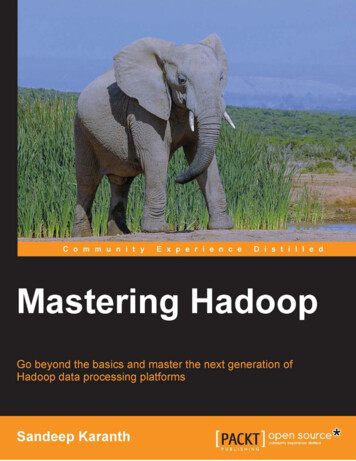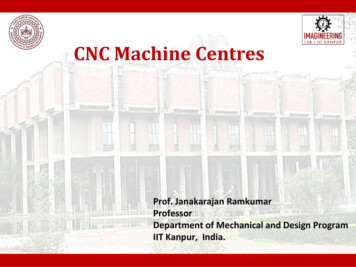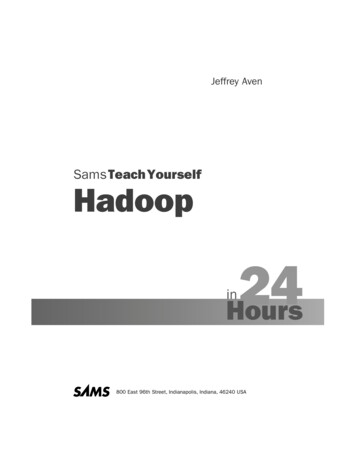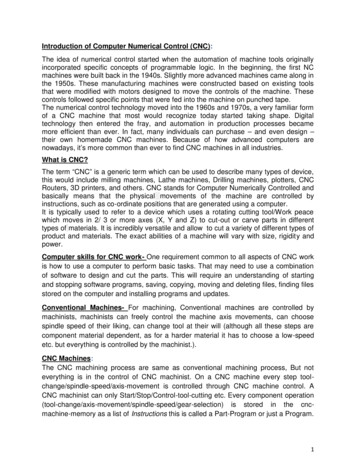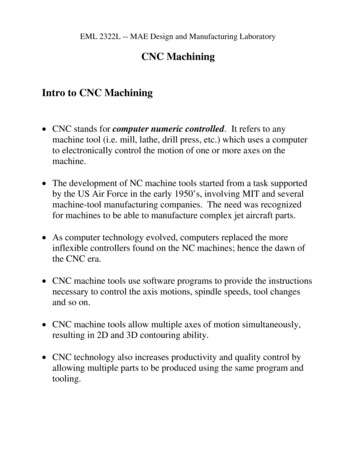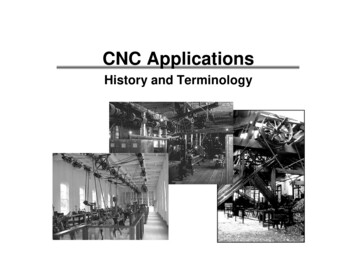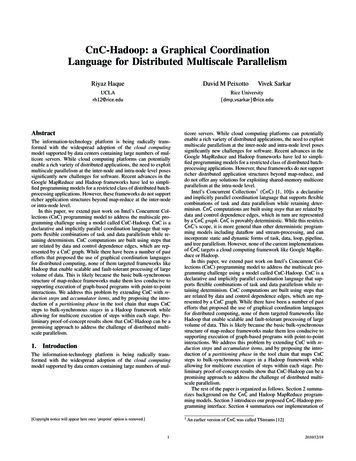
Transcription
CnC-Hadoop: a Graphical CoordinationLanguage for Distributed Multiscale ParallelismRiyaz HaqueDavid M PeixottoUCLArh12@rice.eduVivek SarkarRice University{dmp,vsarkar}@rice.eduAbstractThe information-technology platform is being radically transformed with the widespread adoption of the cloud computingmodel supported by data centers containing large numbers of multicore servers. While cloud computing platforms can potentiallyenable a rich variety of distributed applications, the need to exploitmultiscale parallelism at the inter-node and intra-node level posessignificantly new challenges for software. Recent advances in theGoogle MapReduce and Hadoop frameworks have led to simplified programming models for a restricted class of distributed batchprocessing applications. However, these frameworks do not supportricher application structures beyond map-reduce at the inter-nodeor intra-node level.In this paper, we extend past work on Intel’s Concurrent Collections (CnC) programming model to address the multiscale programming challenge using a model called CnC-Hadoop. CnC is adeclarative and implicitly parallel coordination language that supports flexible combinations of task and data parallelism while retaining determinism. CnC computations are built using steps thatare related by data and control dependence edges, which are represented by a CnC graph. While there have been a number of pastefforts that proposed the use of graphical coordination languagesfor distributed computing, none of them targeted frameworks likeHadoop that enable scalable and fault-tolerant processing of largevolume of data. This is likely because the basic bulk-synchronousstructure of map-reduce frameworks make them less conducive tosupporting execution of graph-based programs with point-to-pointinteractions. We address this problem by extending CnC with reduction steps and accumulator items, and by proposing the introduction of a partitioning phase in the tool chain that maps CnCsteps to bulk-synchronous stages in a Hadoop framework whileallowing for multicore execution of steps within each stage. Preliminary proof-of-concept results show that CnC-Hadoop can be apromising approach to address the challenge of distributed multiscale parallelism.1. IntroductionThe information-technology platform is being radically transformed with the widespread adoption of the cloud computingmodel supported by data centers containing large numbers of mul-ticore servers. While cloud computing platforms can potentiallyenable a rich variety of distributed applications, the need to exploitmultiscale parallelism at the inter-node and intra-node level posessignificantly new challenges for software. Recent advances in theGoogle MapReduce and Hadoop frameworks have led to simplified programming models for a restricted class of distributed batchprocessing applications. However, these frameworks do not supportricher distributed application structures beyond map-reduce, anddo not offer any solutions for exploiting shared-memory multicoreparallelism at the intra-node level.Intel’s Concurrent Collections1 (CnC) [1, 10]is a declarativeand implicitly parallel coordination language that supports flexiblecombinations of task and data parallelism while retaining determinism. CnC computations are built using steps that are related bydata and control dependence edges, which in turn are representedby a CnC graph. CnC is provably deterministic. While this restrictsCnC’s scope, it is more general than other deterministic programming models including dataflow and stream-processing, and canincorporate static and dynamic forms of task, data, loop, pipeline,and tree parallelism. However, none of the current implementationsof CnC targets a cloud computing framework like Google MapReduce or Hadoop.In this paper, we extend past work on Intel’s Concurrent Collections (CnC) programming model to address the multiscale programming challenge using a model called CnC-Hadoop. CnC is adeclarative and implicitly parallel coordination language that supports flexible combinations of task and data parallelism while retaining determinism. CnC computations are built using steps thatare related by data and control dependence edges, which are represented by a CnC graph. While there have been a number of pastefforts that proposed the use of graphical coordination languagesfor distributed computing, none of them targeted frameworks likeHadoop that enable scalable and fault-tolerant processing of largevolume of data. This is likely because the basic bulk-synchronousstructure of map-reduce frameworks make them less conducive tosupporting execution of graph-based programs with point-to-pointinteractions. We address this problem by extending CnC with reduction steps and accumulator items, and by proposing the introduction of a partitioning phase in the tool chain that maps CnCsteps to bulk-synchronous stages in a Hadoop framework whileallowing for multicore execution of steps within each stage. Preliminary proof-of-concept results show that CnC-Hadoop can be apromising approach to address the challenge of distributed multiscale parallelism.The rest of the paper is organized as follows. Section 2 summarizes background on the CnC and Hadoop MapReduce programming models. Section 3 introduces our proposed CnC-Hadoop programming interface. Section 4 summarizes our implementation of1 An[Copyright notice will appear here once ’preprint’ option is removed.]1earlier version of CnC was called TStreams [12]2010/12/18
the CnC-Hadoop programming interface. Section 5 presents preliminary experimental results for CnC-Hadoop, and our conclusions are contained in Section 7.2. Background2.1Concurrent Collections Programming (CnC) ModelIn this section, we give a brief summary of the CnC model, asdescribed in [2]. As in dataflow and stream-processing languages, aCnC program is a graph of communicating kernels. The three mainconstructs in CnC are step collections, data collections, and controlcollections. These collections and their relationships are definedstatically. For each static collection, a set of dynamic instances isgenerated at runtime.A step collection corresponds to a specific procedure, and its instances correspond to invocations of that procedure with differentinputs. A control collection is said to prescribe a step collection—adding an instance to the control collection will cause a corresponding step instance to eventually execute with that control instanceas input. The invoked step may continue execution by adding instances to other control collections, and so on.Steps also dynamically read and write data instances in datacollections. If a step might access data within a collection, then a(static) dependence exists between the step and that data collection.The execution order of step instances is constrained only by theirdata and control dependences. A complete CnC specification is agraph where the nodes can be either step, data, or control collections, and the edges represent producer, consumer and prescriptiondependences. The following is an example snippet of a CnC specification graph, where bracket types distinguish the three types ofcollections ( for control collections, ( ) for step collections, and[ ] for data collections. myCtrl :: (step); // prescribe step// producer/consumer dependence[data1] - (step) - ctrl2 , [data2];The domain expert writes the step implementation code (procedure body) and puts the steps together in a CnC graph as above. Itis in this sense that CnC is a coordination language. The domainexpert says nothing about how operations are scheduled, which depends on the target architecture. The tuning expert2 then maps theCnC specification to a specific target architecture, creating an efficient schedule. Thus the specification serves as an interface between the domain and tuning experts. This is quite different fromthe more common approach of embedding parallelism constructswithin serial code.Within each collection, control, data, and step instances aredistinguished by unique tags. These tags generally have meaningwithin the application. For example, they may be database keysor tuples of integers modeling an iteration space. Each type ofcollection uses tags as follows: Putting a tag into a control collection will cause the correspond-ing steps (in prescribed step collections) to eventually execute.A control collection C with tag i is denoted C : i .Each step instance is a computation that takes a single tag(originating from the prescribing control collection) as an argument. The step instance of collection (f oo) at tag i is denoted(f oo : i). A data collection is an associative container indexed by tags.The entry for a tag i, once written, cannot be overwrittenthereby satisfying the dynamic single assignment rule. Theimmutability of entries within a data collection is necessary2 Thetuning expert may be a human or an automated tool.2for determinism. An instance in data collection x with tag i isdenoted [x : i].Because control collection tags are effectively synonymous withcontrol instances we will use the terms interchangeably in theremainder of this paper. We will also refer to data instances simplyas items, and operations on collections as puts and gets.A CnC specification can optionally include tag functions [5]and use them to specify the mapping between a step instance andthe data instances that it consumes or produces. A tag function canbe the identity function, or can define nearest neighbor computations, a parent/child in a tree, neighbors in a graph, or any otherrelationship useful in the application.2.2 Hadoop MapReduce Programming Model2.2.1MapReduceMapReduce [3] is a programming model for large-scale distributedbatch processing. It is suited for applications that process largeamounts of independent data in a parallel manner. This is achievedby distributing a large data input file into fixed-size chunks amongthe nodes in the cluster. The distribution is performed transparentlyby the runtime with the help of the underlying file system. Eachchunk in turn is conceptually organized into a list of records. Logically a record is a key, value pair and can have any suitableformat based on application logic. Only the following two interfaces are available to the programmer: map(key k, value v, output Set k’, v’ ): map is the process thatis run independently for each record. Each map takes as input arecord k, v and computes a set of outputs records k’, v’ .Following the “owner computes” principle, the Hadoop runtimesystem schedules a map operation to run at the node where therecord is stored, no data transfer is required between the nodes.Once map is over, the runtime reorganizes output records. Eachoutput record k’, v’ generated by the map task is stored at aplace calculated as a function of k’. reduce(key k’, Set value v’, output Set k’, v” ): reduceperforms an aggregation over a list of values v’ and generatesa final output record k’, v” . Similar to map, since all valuesfor a key k’ are moved to the same node by the runtime after themap task, no data transfer between nodes is required during thereduce task. The final output of the entire computation is the setof records k’, v” .Note that each instance of map and reduce is independent and sequential. Parallelism is created implicitly by the framework throughthe scheduling of tasks concurrently on different nodes. The programmer only needs to implement the map and reduce interfaces,in any language of one’s choosing. Without having to deal with explicit parallelism constructs, writing distributed programs is simplified. Since individual tasks do not need to communicate with eachother, this approach is scalable to a very large number of nodes. Inaddition to high scalability, MapReduce also provides implicit support for fault tolerance and load-balancing among the cluster nodes.Figure 1 shows the steps involved in the execution of a Map-Reducejob on a 2-node cluster.2.2.2HadoopHadoop [6] is a Java-based implementation of MapReduce. TheHadoop framework comprises of the following components: Hadoop Distributed File System (HDFS): HDFS [6] is a dis-tributed file system based on the Google File System [8]. AnHDFS file is divided into fixed-sized chunks across the nodesin the cluster. The default size of the chunks is 64MB. Additionally, to provide fault tolerance, several copies (default 3) of2010/12/18
Configurationm r 1m r 2m r 4Execution Time910.730 s475.183 s246.617Table 1. Execution times in seconds for WordCount on an input ofsize 3 GB as a function of the m and r parametersFigure 1. Map-Reduce job on a 2-node cluster. (1) Read inputrecord from local HDFS chunk (2) Perform map on each record(3) Shuffle output data across nodes (4) Perform reduce (5) Writeoutput to local HDFS store.each chunk are created on different nodes. In the HDFS setupone node called NameNode is designated as the master and therest of the nodes are configured as workers called DataNodes.The NameNode maintains the meta-data about the file systemand the DataNodes store the actual data chunks. This partitioning of files by HDFS determines where the map tasks are scheduled by the Hadoop runtime. JobTracker: JobTracker is a process created by the Hadoopruntime on a node designated as a master node. This process isresponsible for creating individual processes on the other nodes,tracking their progress and providing fault tolerance. TaskTracker: TaskTracker is a process created at each workernode that performs the actual map and reduce tasks. A TaskTracker reports heartbeats to the JobTracker at regular intervals. If it fails to do so, the JobTracker can decide whether theTaskTracker has crashed and take appropriate action for faulttolerance.We conclude this section with a brief summary and evaluation ofhow multicore parallelism is exploited in MapReduce jobs. Hadoopoffers two configuration parameters,m mapred.tasktracker.map.tasks.maximum andr mapred.tasktracker.reduce.tasks.maximum,make that can be set in the hadoop-site.xml file. If m and r areset to the number of processor cores in a node, p, then the Hadoopruntime system will partition the intra-node workload in the mapand reduce phases to contain each p tasks to exploit p-way multicore parallelism. To verify the effectiveness of this level of parallelism, we ran the canonical WordCount example described in [3]on an input file of size 3 GB that was created by concatenating textfrom several files taken from the Gutenberg project [9]. The evaluation was performed on a small-scale distributed Hadoop clusterconsisting of 4 nodes with 4 cores per node, using HDFS as itsunderlying file system.Table 1 displays the execution times for the WordCount example measured for m r 1, m r 2, and m r 4.(m r 2 is the default setting for Hadoop on our test system.) As can be seen, a respectable speedup of 3.7 is obtained bychanging the configuration parameters. However, these parameterscannot help with situations where less-structured dynamic parallelism needs to be exploited within a map task or reduce task.3. CnC-Hadoop Programming InterfaceIn this section we describe the extensions to CnC needed to implement the Map-Reduce model and the interface used by the programmer to describe Map-Reduce computations.3.1 Extensions to CnCCnC is extended with accumulator collections, reduction steps, anddata distributions as described below.Accumulator CollectionsAccumulator collections are item collections with some uniqueproperties.1. Multiple put operations are allowed for the same tag, eventhough doing so may appear to violate the dynamic singleassignment rule. Mapper: The Mapper interface defines the map() method which2. The get operation returns a set of values instead of a singlevalue.must be overridden by the programmer in order to implement amap task.3. A get will block until all steps that write to the collection havecompleted. Reducer: The Reducer interface defines the reduce() methodIn standard CnC, multiple puts for the same tag would bean error, but accumulator collections allow multiple puts for thesame tag. All of the values that were put for a given tag will beaccumulated and returned as the result of a get for that tag. Theget operation for accumulator collections is changed to alwaysreturn a set of values (if only a single put is done for a tag then theresult will be a singleton set). The get on a accumulator collectionwill block until all steps writing to the collection have completed.Thus a get will always return the full set of values and any twogets for the same tag will always return the same set of values.which must be overridden by the programmer in order to implement a reduce task. JobConf : Every map-reduce job needs to define a driver classwhich configures and initiates a map-reduce job. This configuration information is submitted to the Hadoop runtime througha JobConf object.In addition to these Hadoop also provides built-in support for certain specific record types, an interface for performance monitoringand advanced features like partitioners to expose some load balancing capability to the programmer.3Reduction Steps2010/12/18
Reduction steps enable efficient reductions over the items in anaccumulator collection. The reduction step differs from a standardstep collection in two ways.1. Reduction steps are not prescribed by a control collection.2. A reduction step may only read from accumulator collectionsin the CnC graph.A reduction step does not get prescribed explicitly by the programmer. Instead, when a value is put into the accumulator collection that the reduction step reads from, the reduction step will beprescribed for that tag. Multiple puts for the same tag will onlyprescribe a single reduction step for that tag.Reduction steps have a restricted form that emphasizes their roleas a reduction operation. A reduction step may only read from anaccumulator collection in the CnC graph. It is not permitted to readfrom arbitrary item collections. The reason for this restriction isthat the body of a reduction step does not have access to any itemcollections. The step body is passed two items from the accumulator collection when it executes and it returns the reduction of thosetwo items. The reduction step is used by the runtime to computea reduction over all of the items in an accumulator collection. Thefinal reduction value is written to the output collection connected tothe reduction step in the CnC graph. For convenience, we requirethat any path in the static CnC graph that includes a reduction stepcannot be a cycle. However, a cycle in the graph that includes onlynormal (non-reduction) steps is permitted.Reduction steps are defined this way to allow the runtime theflexibility to choose how to implement the reduction. A reductioncan be performed eagerly as the items are put into the accumulator collection, or it can be done lazily after all the items have beenwritten to the collection. It would also be possible to provide efficient version of common reduction operations, (e.g. sum, max) thatcould be implemented without the overhead of invoking a reductionstep for each pair of items.DistributionsEach item collection can specify a distribution function whichwill be used to partition data keys if the collection is used in areduce operation. This corresponds to the Map reduce abstractionof a Partitioner class, which helps divide the key space for effectiveload balancing. A step may only read data from an item collectionif the step and the data are located at the same place.3.2SyntaxWe propose adding a special syntax to the CnC graph language tosupport accumulator collections and reduction steps. The new syntax simplifies the task of the CnC translator in enforcing the rulesfor using accumulator collections and reduction steps. A reductioncan be expressed in CnC as[[Accumulator]] - ((Reduction)) - [Output]which says that the collection Accumulator is reduced usingthe reduction Reduction and the result of the reduction is placedin the item collection Output.If the CnC graph contains a non-reduction step that reads froman accumulator collection then that step can perform gets onthe collection as described in Section 3.1. Reduction steps aredistinguished from normal steps by the double parentheses syntaxin the graph.3.3Operational SemanticsWe take an operational view of a CnC program and describe theexecution by sketching a state transition system. The state of a CnCprogram is a 4-tupleState (Steps, Items, Accums, Graph)4The Steps element contains all of the currently executing steps,the Items and Accums elements contains the item and accumulator collections, and the Graph element is the static graphas described by the programmer. Each executing step is a tuple(LocalStore, Code) that contains the local variables for that stepand the code to execute. The code for a step body contains instructions of the form:Put c tag var Put the variable var from local store to collection c with tagtag.Get c tag var Get the item in the collection c with tag tag and store it in thelocal store with the name var.Pre c tag Put the tag tag to the tag collection c to start the steps prescribed by the tag collection.Compute f Perform the computation f on the local store. This allows forarbitrary computations with local variables and returns andupdated local store.A full CnCcomputation can be described as follows:state initialStatewhile (! FinalState(state) ) {state Schedule(Next(state))}The initialState is setup according to the Put instructionsperformed by the environment. The FinalState predicate is truewhen there are no more steps to execute in the Steps portion of theprogram State. The Schedule and Next functions are responsible for updating the computation state. The Next function takes thecurrent state and returns the next state based on the next instruction in the first step of the Steps component of the state. Definingthe Next function based on just the first step simplifies its definition. We allow arbitrary scheduling of steps through the Schedulefunction which takes the Steps component and permutes the orderof the steps as desired. The Schedule function could be a simpleround robin, a random schedule, or a “smart” schedule based on thedependencies in the graph. The Next function is at the core of thesemantics and we describe it in detail below.In the description below we use pattern matching to deconstructthe state. A : is used for list matching. For example Compute f:insnswould be a list of instructions whose first element is Compute fand whose remaining elements is captured by the variable insns.An empty list is denoted by []. A pattern match can be augmentedwith guard conditions, which are preceded by a . The guard condition must be true for the match to be successful. Finally, in thefunction definition we use a form of list comprehension syntax. Alist comprehension contains an expression on the left side and agenerator with predicates on the right side, separated by a . Thevalues are generated and any value that passes all the predicates ispassed to the expression on the left hand side. We can now give thefull definition of the Next function.Item Collection Put A put to an item collection must verify thatthere is no value already defined for that item collection at the giventag to satisfy the single assignment condition. The state is updatedto reflect the new value added to the item collection.Next((ls, Put ic t v:insns):ts, ics, acs, g) Member(ic, ics) ic[t] undefined ls[v] val ((ls, insns):ts, ics’, acs, g)2010/12/18
where ics’ ics with ic updated so ic[t] valItem Collection Get There are two cases to consider for a getfrom an item collection. If the value is available in the collectionat the given tag, then we simply add a binding in the local store.If the variable is not available then we return the state unchangedwith the idea that the Schedule function can schedule the task thatwrites that value so that we will be able to eventually proceed.Next((ls, Get c t v:insns):ts, ics, acs, g) Member(c, ics) c[t] ! undefined ((ls’, insns):ts, ics, acs, g)where ls’ ls with ls[v] c[t]Next((ls, Get c t v:insns):ts, ics, acs, g) Member(c, ics) c[t] undefined ((ls, Get c t v:insns):ts, ics, acs, g)Step Prescription When a put is done on a tag collection, welook up the code for all the steps prescribed by the tag collection.These steps are given an initial local store that maps the variable‘tag’ to the actual tag value.Next((ls, Pre c t:insns):ts, ics, acs, g) ((ls, insns):ts new, ics, acs, g)where new [("tag" - t, code) code - steps]steps Prescriptions(g,c)Local Computation A local computation acts on the local storeof a single step. We simply replace the local store of the step withthe result of applying the computation to the current local store.Next((ls, Compute f:insns):ts, ics, acs, g) ((ls’, insns):ts, ics, acs, g)where ls’ f(ls)Accumulator Collection Put An accumulator collection allowsmultiple puts for the same value, so we do not need to verify thatthere is no value currently in the collection for the given tag. Thevalue from the local store is added to the collection of values (ifany) already present in the collection under the given tag.Next((ls, Put ac t v:insns):ts, ics, acs, g) Member(ac, acs) ls[v] val ((ls, insns):ts, ics, acs’, g)where acs’ acs with ac updated so ac[t] valAccumulator Collection Get A get on an accumulator collection is similar to a get on an item collection. The key difference iswhen we can write the value from the collection into the local store.In the case of an item collection we know that only one value willbe written for a given tag so we can just check to see if a value existsfor the tag. However, an accumulator can collect multiple puts forthe same tag so we must use some other mechanism for decidingwhen all values have be put to the collection. We use the Completepredicate to decide when an accumulation has finished. Completeis a key predicate and we will say more about it below. !Complete(c) ((ls, Get c t v:insns):ts, ics, acs, g)Step Termination A step terminates when all of its instructionshave executed. At this point we can check to see if we can runany reductions and write its value to the output item collection. Wecheck for available reductions by looking at all the reductions thatoccur statically in the graph. That is we check for reductions of theform [[ac]] - ((r)) - [ic]. For each reduction we see ifthe accumulator collection is Complete using the same predicate asfor gets from accumulator collections. If the collection is completethen we perform the reduction for each tag in the collection andwrite the output to the item collection using the same tag.Next((ls, []):ts, ics, acs, g) (ts, ics’, acs, g)whereics’ ics with collections updated forall item collections in newnew [ic[t] reduce(r, ac[t]) t - Tags(ac),Complete(ac),IsReduction(g, ac, r, ic),ac - acs,ic - ics,r - Reductions(g)]Computing Complete for Hadoop-CnCThe Complete predicate is used in two places for accumulatorcollections. First, it is used when performing a get from the collection to make sure that all values are present so that consumers willsee the same result of doing a get. Second, it is used at step completion to see what reductions could possibly be run. The reductionsteps are not spawned as normal steps with control tags, but ratherare run when the accumulator collection is complete. Obviously wecan only write out the result of the reduction once all of the inputvalues have been processed.Conceptually, the Complete predicate should be true whenthere will be no more data put to the collection. In general computing Complete is a hard problem, but we can use the structureof the graph and the properties of the Hadoop framework to efficiently compute the Complete predicate. Hadoop guarantees thatall the map tasks will complete before any reduce task starts. Sincethe map tasks will be generating the data we know that once all themap tasks are finished no more data will be generated. We use thedistinct map/reduce phases of Hadoop to substitute for computingthe Complete predicate.Using the Hadoop phases to compute the Complete predicaterequires us to partition the CnC graph into distinct phases. Thefull CnC graph is partitioned into phases so that there are nodependencies between steps in the same phase. So for example,if we have this CnC graph(p) - [[A]] - ((r)) - [O] - (c)then we would have to partition p and c into separate phasessince there is a producer/consumer relationship between the steps.3.4 Patterns for Collective Communication in CnCNext((ls, Get c t v:insns):ts, ics, acs, g) Member(c, acs) Complete(c) ((ls’, insns):ts, ics, acs, g)where ls’ ls with ls[v] c[t]In this section we describe how accumulator collections can beused to implement barrier, gather, and (along with a reduction step)reduction operations.BarrierThe semantics of accumulator collections allow them to beused as barriers between different phases of a computation. TheNext((ls, Get c t v:insns):ts, ics, acs, g) Member(c, acs)52010/12/18
key property of accumulator collections that allows them to act asbarriers is that that get operation will block until all steps that writeinto the collection have completed execution. The accumulatorcollection can then be used as a barrier by having all steps in phaseone write a dummy value to the collection and have all steps inphase two read (and throw away) the dummy value.The code below shows an example of a barrier operation. Thesteps in phase one write to the Barrier collection using the arbitrary tag "BARRIER" and the steps in phase two read from thecollection using the same tag.// CnC Graph(phase1) - [[Barrier]] - (phase2)// Step Codephase1(tag, Barrier) {Barrier.put("BARRIER", null)}phase2(tag, Barrier) {Barrier.get("BARRIER")}The example below shows how a reduc
gramming challenge using a model called CnC-Hadoop. CnC is a declarative and implicitly parallel coordination language that sup-ports flexible combinations of task and data parallelism while re-taining determinism. CnC computations are built using steps that are related by data and control dependence edges, which are rep-resented by a CnC graph.
